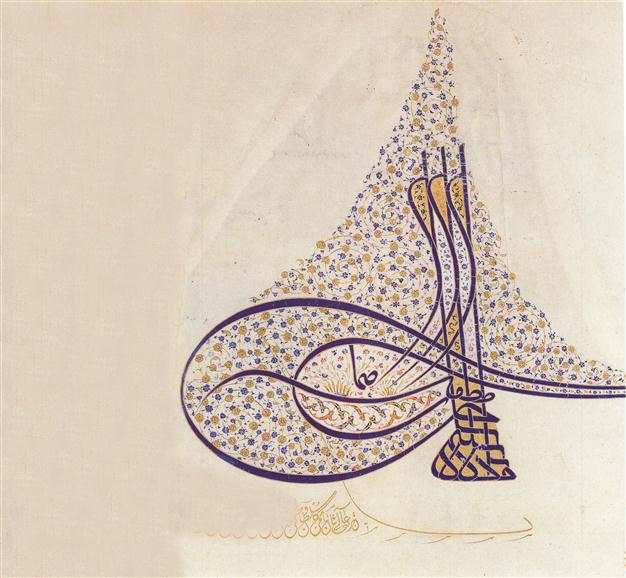Tuğras, fermans and the Ottoman legal system
NIKI GAMM Hürriyet Daily News

The ink used to draw the tuğra was often
made from gold or other metals and the
text itself would be in lampblack ink. Each
straight line, twist and semi-circle meant
something although today there is some
dispute over just what the meaning might be.
The Ottoman Empire was basically governed by two different types of law. One was the prescriptions of religious law, the shariah, which almost exclusively regulated the lives of Muslim individuals and offered few guidelines for the administration of a country. Non-Muslim religious authorities dealt with the individuals in their religious communities.
The second type of law, known as örf, has been described as public or civic law, in other words the law as laid down by the sultan. In the latter instance, the proposed law was first cleared by the top religious authority among the Ottomans, the Sheikh ül-Islam, before being presented to the sultan for approval. The sultan only rarely intervened in cases involving religious law. As the Ottoman Empire expanded, the use of örf allowed the rulers to extend their rule over diverse communities and traditions.
The court system, however, was based on shariah, and judges who were appointed and paid by the centralized Ottoman government in Istanbul presided over the courts. That gave the Ottoman administration a certain amount of control over the judges because it could dismiss them and replace them with other appointees.
The laws issued by the sultan were known as ferman, originally a Persian word that translated as “edict” or “decree.” Since the sultan was constrained from issuing a ferman that contravened the shariah or private law, he could not issue one that was based on his own personal whim.
For example, Murat IV (r. 1629-1640) attempted to prohibit coffee, coffeehouses and tobacco as part of his campaign to end disorder and corruption throughout the empire, not because he personally disliked those substances. The ferman, which required a tuğra (calligraphic monograms or imperial signatures), was used to regulate relations, status, duties and dress of aristocracy and subjects. The berat, which was another decree that required a tuğra, indicated the recipient had been granted a position or even a property that belonged to the sultan.
Today when we think about the Ottoman fermans, what comes to our minds are the tuğras that had to appear on every ferman and other such proclamations for them to be legal. Several calligraphers were employed just to execute the very elaborate official designs. We also find tuğras on the sultan’s seal and coins as well as on buildings at places like Topkapı Palace and on the fountain of Sultan Ahmed III. The earliest use of such a tuğra dates back to 1326 with Orhan Bey, the second Ottoman ruler. It is quite a plain design unlike the extremely fanciful ones of later sultans.
The ink used to draw the tuğra was often made from gold or other metals and the text itself would be in lampblack ink. Each straight line, twist and semi-circle meant something although today there is some dispute over just what the meaning might be. Each tuğra contained the name of the sultan and that of his father, their titles and an honorific such as “the victorious.” The empty spaces, if there were any, would often be filled with small flowers and hancer (sharply pointed) leaves. These are the same kinds of flowers and leaves that one sees in the famous İznik tiles and in embroideries.
Today we can see some extant examples such as in the Museum of Turkish Calligraphic Art at Bayezid in Istanbul that includes tuğras on documents among the many works to be found there. It is the only calligraphic museum in Turkey. Some of the best examples of fermans and berats are to be found in the Sakıp Sabancı Museum’s calligraphic collection, which is currently on show in Athens, Greece. It will be back on display in January.
If newspaper accounts are correct, Istanbul will eventually have a ferman museum based on the collection of Remzi Gür, the CEO of Gürmen Textiles. Part of his collection (he has 150 pieces in his collection) is now on display in London. He is currently looking for a location for his ferman museum somewhere on the Anatolian side of Istanbul.
Can you still collect fermans? Yes, but the price is likely to be steep either at an auction or through a private sale.

